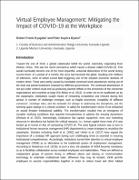| dc.description.abstract | Toward the end of 2019, a global catastrophe befell the world, ostensibly originating from Wuhan, China. This was the novel coronavirus which causes a disease called COVID-19. This would eventually become one of the most impactful, universal distractions of the world during current times. In a period of 4 months, the virus had traversed the globe, resulting into millions of infections, some of which turned fatal triggering one of the sharpest economic declines of modern times. These were partly caused by inevitable continued work absenteeism arising out of the total and partial lockdowns imposed by different governments. The continued absenteeism if not put under control could end up producing adverse effects to the economies of the concerned organizations and countries at large (De Blasio et al. 2012). In order not to be swallowed up by the catastrophe, institutions sought means of remaining competitive and relevant during this period. A number of challenges emerged, such as fragile economies, instability of different currencies’ exchange rates, and the demands for change in addressing the disruptions, put the working space settings in a critical condition. It called for transformation which if not embarked on would threaten institutional stability. The transformation resulted into an emergence of complex working conditions that required innovativeness to address the ensuing dynamisms (Winasis et al. 2020). Interestingly, institutions had capital, equipment, time, and marketing resources in abundance but lacked the critical resource, i.e., human capital since most of it was locked up in homes in fear of contracting COVID-19. The most logical solution was to turn to institutional human resources management (HR) departments to create strategies to neutralize the catastrophe. Scholars including Snell et al. (2002) and Ulrich et al. (2017) have argued the importance of a strategic HR approach during such challenging times as essential in ensuring institutional competitiveness. Accordingly, institutions turned their attention to virtual employee management (VEM) as an alternative to the traditional system of employment management. According to Henderson et al. (2016), at such a time, the adoption of VEM becomes mandatory so as to facilitate collaboration across isolated employees and stake holders. These are defined as codependent groups of persons living in different places and relying on communication technology to undertake institutional tasks. Wherever they may be located, VEM permits employees to execute responsibilities together in order to reduce travel and other related expenses, time, stress, and the spread of contagious diseases as is the case with COVID-19 today. It became necessary for institutions to adopt this method since it had been in existence since the times of the industrial revolution. | en_US |


